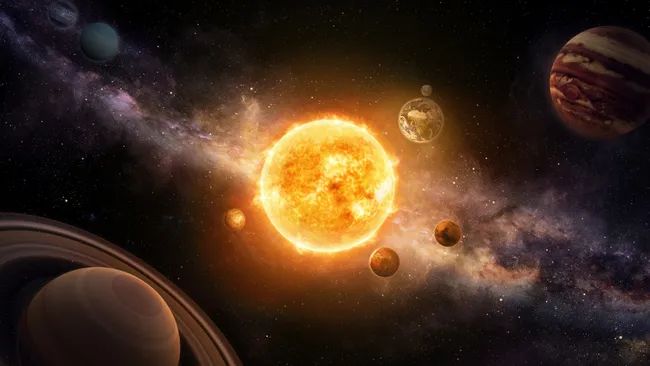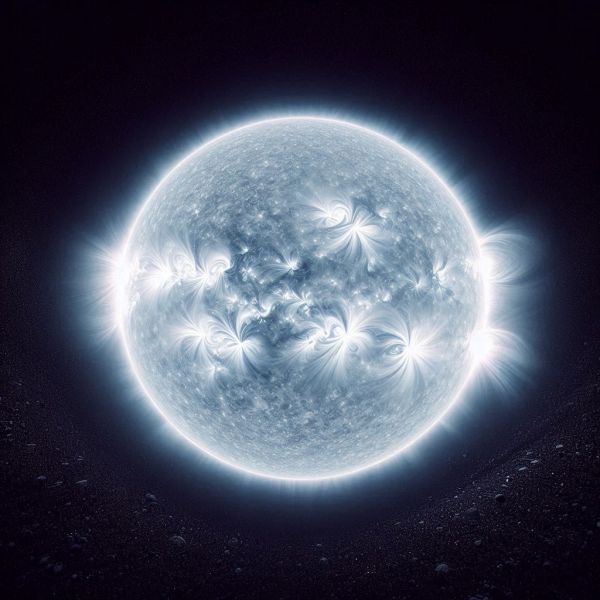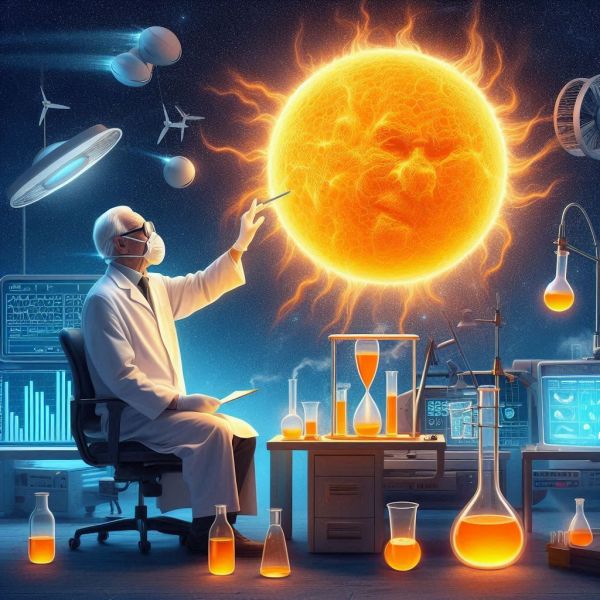
Did you not know that the Sun is actually not yellow? Let’s figure it out.
Why do we see the Sun as yellow?
We often refer to the color of the sun, meaning yellow. This is incorrect because, in reality, the Sun 🌞 is not just yellow. We see it that way from Earth on a clear day.
The Sun is the central star of the Solar System, which is a plasma sphere with a radius of 696,230 km.
The distance from Earth to the Sun is 149,597,870,700 meters, or 1 astronomical unit. This measure was established in 2012 by the General Assembly of the International Astronomical Union.
| Diameter of the Sun | about 1.39 million km (109 times greater than the diameter of the Earth) |
| Mass of the Sun | 1.99 x 10^30 kg |
| Surface temperature | 5500 °C |
| Core temperature | more than 5 million °C |
The amount of energy a star produces in one second is 383 septillion joules.
The Sun weighs 2 million billion trillion tons. Which constitutes 99.8% of the mass of the entire Solar System. This is 333,000 times more than the mass of the Earth.
The atmosphere of the Sun consists of three layers:
- The photosphere – the visible surface of the Sun, the lowest layer of its atmosphere, about 400 km thick. This is where light and heat come from to reach the Earth.
- The chromosphere – the next layer of the solar atmosphere, with a thickness of about 2000 km.
- The corona – the upper layer, which transitions into what is known as the solar wind.
The rotation of the Sun is differential. Around its axis, the Sun rotates in about 27 days. While at the equator it rotates faster in 25 days.
What color is the Sun in space?
When astronomy, as a science, was just emerging, the Sun was often referred to as a yellow dwarf. Now, scientists use a more precise terminology – a main-sequence star of spectral class G. These are stars with temperatures ranging from 5000 to 6000 K and are perceived by the eye predominantly as yellow, as our perception is influenced by the Earth’s atmosphere.
However, in space, there is no atmosphere, so the true color of the star can be seen. The Sun is actually not yellow. From a spacecraft, the Sun appears white.
What is the electromagnetic spectrum?
The electromagnetic spectrum is the range of frequencies of electromagnetic radiation emitted or absorbed by an object. Photons of light are considered based on one of three parameters: frequency, wavelength, or intensity of its energy.
The Sun’s light spectrum is continuous but not uniform. In the upper cold layers of the star’s atmosphere, dark lines are visible. In the photosphere, it is almost black, and in the long-wavelength range, the color varies from blue to red.
The bright palette of the star is created by its chemical composition. It consists of more than 73% hydrogen, 24.5% helium, and less than 2% of other elements.
In the visible range, the Sun emits half of its energy. Moreover, only 9% comes from ultraviolet radiation. That’s why the Sun appears black, and 41% in infrared radiation, which makes it appear red.
What color is the Sun really?
In reality, the Sun is white, which is clearly visible from space.

When direct rays enter the atmosphere, they scatter, part of the light is absorbed, and the color is perceived by the human eye as yellow, orange, or red.
If we consider the spectrum by frequency range rather than by wavelength, the red color will appear more intense.
So why don’t we see a green, black, or blue sun? Because only powerful optics can recognize the entire spectrum of the Sun. The human eye does not perceive the ranges of X-ray, infrared, and ultraviolet radiation. Just as we do not see the spectrum of waves in a microwave oven.
Where did the theory of a green Sun come from?
Surprisingly, the peak of the solar spectrum is green, with its wavelength being the most intense. However, this peak is very short, and not all modern instruments can capture it.
The sensational theory of a green Sun was sparked by an article from British astrophysicist Alastair Gunn of the Jorell-Bank Astrophysical Center. A heated global discussion ensued.
Physicists put an end to the debate by explaining the greenish-turquoise color of the Sun. This is due to the high temperature. And resembles the color scheme of a heated soldering iron.
Why does the color of the Sun change?
White is the ideal color. White light contains all visible spectral colors in equal proportions. Let’s recall the phenomenon known as a rainbow, which occurs when sunlight is refracted.
Moreover, white light has the property of reflecting most of the light. This is especially noticeable when the Sun is at its zenith, literally blinding us with its brightness. The short blue wavelengths at noon collide with air molecules, creating the effect of a blue sky.
The color of the Sun at dawn is quite different; it slowly rises above the horizon and appears orange to us. The Sun has the same color at sunset. This is because, at these times, its rays have to traverse the maximum amount of the Earth’s atmosphere, scattering the shorter blue wavelengths. Longer red photons are partially scattered. The human brain interprets them through vision as yellow or orange.
The Sun takes on a red hue due to atmospheric haze or dust, which enhances scattering. But this is just an illusion. The Sun itself does not change color.
How will the color of the Sun change in the future?

Scientists believe that as the Sun ages, it will change its color. However, this will not happen for at least another 5 billion years. When the star uses up all its hydrogen. Currently being converted to helium at its core. Collapse will occur when the balance is disrupted. This is between the internal gravitational pressure and the external radiation of the star.
As a result, the helium in the core will break down into heavier elements. The outer shell of the Sun will expand from the inside. Eventually it will reach the orbit of Mars. And the color of the star will become reddish-brown. The entire Solar System will be affected. With Mars, Venus, Mercury, and Earth facing the threat of destruction.
This will not be the only transformation for the Sun. As the star’s shell expands, it will begin to cool. In about 10 billion years, its core will turn into smoldering coal of a white-blue color. And after trillions of years, the Sun will completely lose its shell. Become a small black cosmic dwarf. While the entire Solar System will be plunged into darkness.